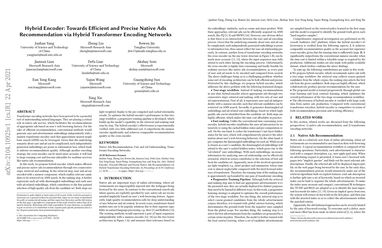Hybrid Encoder: Towards Efficient and Precise Native AdsRecommendation via Hybrid Transformer Encoding Networks
Transformer encoding networks have been proved to be a powerful tool of understanding natural languages. They are playing a critical role in native ads service, which facilitates the recommendation of appropriate ads based on user's web browsing history. For the sake of efficient recommendation, conventional methods would generate user and advertisement embeddings independently with a siamese transformer encoder, such that approximate nearest neighbour search (ANN) can be leveraged. Given that the underlying semantic about user and ad can be complicated, such independently generated embeddings are prone to information loss, which leads to inferior recommendation quality. Although another encoding strategy, the cross encoder, can be much more accurate, it will lead to huge running cost and become infeasible for realtime services, like native ads recommendation. In this work, we propose hybrid encoder, which makes efficient and precise native ads recommendation through two consecutive steps: retrieval and ranking. In the retrieval step, user and ad are encoded with a siamese component, which enables relevant candidates to be retrieved via ANN search. In the ranking step, it further represents each ad with disentangled embeddings and each user with ad-related embeddings, which contributes to the fine-grained selection of high-quality ads from the candidate set. Both steps are light-weighted, thanks to the pre-computed and cached intermedia results. To optimize the hybrid encoder's performance in this two-stage workflow, a progressive training pipeline is developed, which builds up the model's capability in the retrieval and ranking task step-by-step. The hybrid encoder's effectiveness is experimentally verified: with very little additional cost, it outperforms the siamese encoder significantly and achieves comparable recommendation quality as the cross encoder.
PDF Abstract
